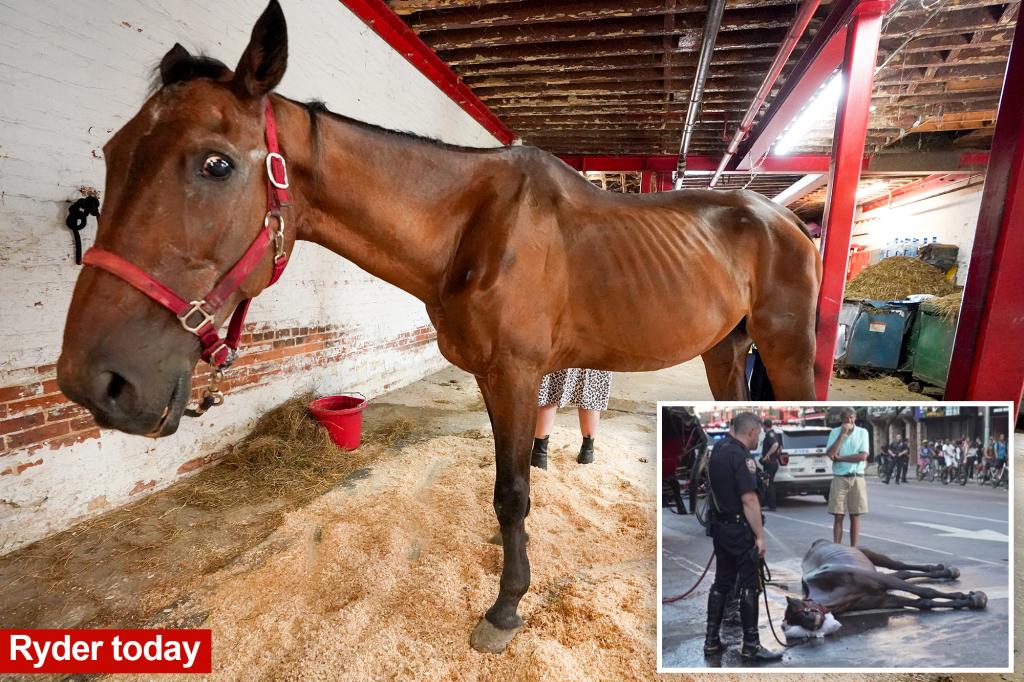The sick carriage horse that collapsed on a busy Manhattan street won’t be sold off or euthanized as a result, a stable employee insisted to The Post on Thursday.
The horse, named Ryder, spent the night at the West Side Livery stables on West 38th Street after he was filmed lying in the middle of the street in Hell’s Kitchen as his driver repeatedly struck him and ordered him to “get up.”
Christina Hansen, a carriage driver who works at the stable, told The Post it was “highly unlikely” the 14-year-old horse would be put down or sold off following Wednesday’s caught-on-camera order.
“He’s not going to be sold,” the top hat-wearing Hansen said, adding that she’d spoken to the horse’s owner earlier Thursday.
Ryder was examined by a veterinarian after being brought back to the stable by the NYPD’s mounted unit following his collapse — and the diagnosis was Equine Protozoal Myeloencephalitis, a neurological disease caused by possum droppings, Hansen said.
Hansen said it was unlikely the horse would be put back to work immediately because he’ll need treatment for EPM.


“It would be irresponsible,” Hansen, who is also a union shop steward, said of having him lug a carriage right away.
“We have all the time in the world. We’ll do what’s right by the horse. He’s going to be treated and we’ll figure out one of the best places for him to retire to,” she added.
The stable worker said Ryder, who has only been in the Big Apple since April after being used as an Amish buggy horse, was already doing “really well.”
“He’s been great. He’s been plowing through there. He’s been eating his carrots,” Hansen said.
Her insistence that Ryder won’t be cast aside came after the president of NYCLASS — an anti-horse carriage group — claimed the horse was at risk of being sold for slaughter following his collapse.
“If the owner simply sells Ryder, he is at serious risk of ending up being sold for slaughter or in some other terrible situation,” Edita Birnkrant said in a statement.
Birnkrant said the organization had already offered to “place Ryder in a sanctuary where he would receive lifelong love and care and proper veterinary care.”


Meanwhile, animal activists — including NYCLASS — descended on City Hall on Thursday to call on the City Council to fast track legislation that’ll phase out horse carriages in the Big Apple. That bill was introduced by Councilman Bob Holden last month.
If passed, the new measure would give horse drivers preferences for electric carriage licensure and require they be paid union wages.
“The collapse of Ryder in peak rush hour traffic in Midtown Manhattan is tragic, unforgivable … and entirely preventable,” said Dr. Jim Keen, director of Veterinary Sciences for Animal Wellness Action and the Center for a Humane Economy.


“Whether he collapsed from overwork and heat exhaustion, or, even worse, overwork, heat exhaustion and untreated EPM, there is no excuse to treat a horse like an expendable machine. There is a simple solution: prohibit carriage horses from dense urban areas, and replace them with electric carriages as Councilman Bob Holden proposed.”
Ashley Byrne, PETA’s director of outreach and communication, said the legislation, if passed, would “be a win for everyone.”
“It would be a win for the workers. Their jobs would be preserved and would be much better and have benefits. It would also protect the public from accidents and run away horse incidents, that we have seen far too many of. And obviously a win for the horses,” she said.


Mayor Eric Adams didn’t answer questions about the horse collapse Thursday.
One protester, Lisa Forsee, 60, took direct aim at Hizzoner over his silence.
“I am ashamed of him. He is running this city. He is allowing animal abuse. It’s documented. He needs to do something about it,” she said.
Additional reporting by Desheania Andrews
.











